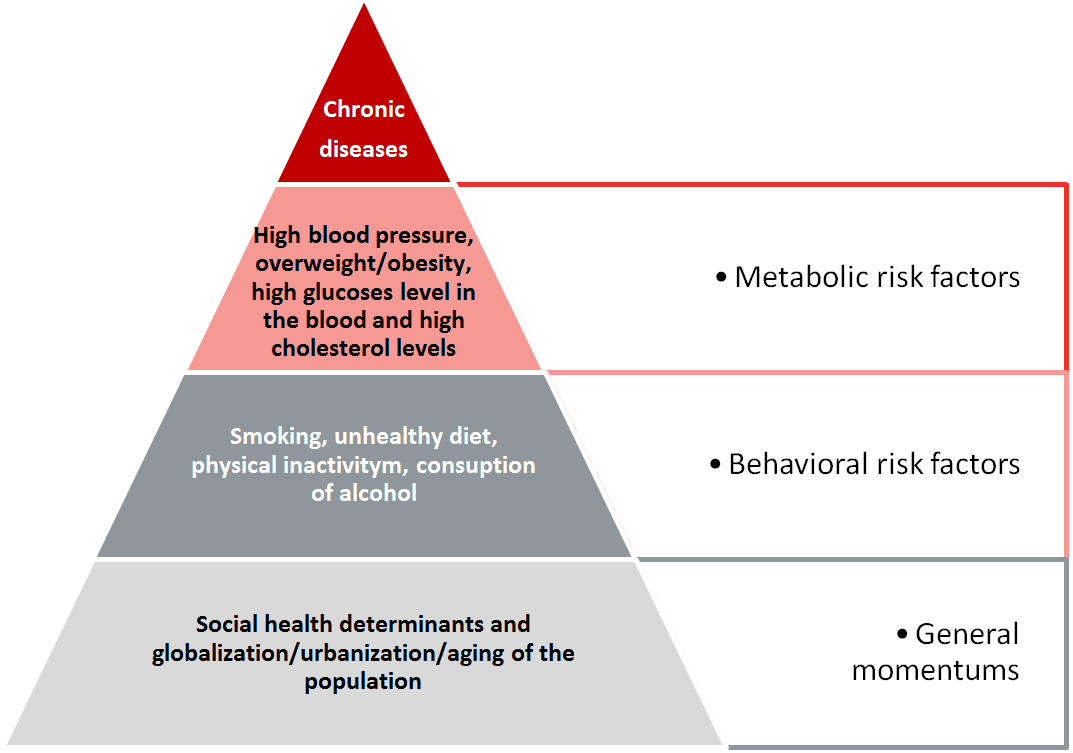—
HPI Network > HPI - Health Policy Institute > Lectures > We are living in the era of chronic diseases (lecture 1/8)
We are living in the era of chronic diseases (lecture 1/8)
Thursday, 16. May 2013, 13:58 — Peter Pažitný
Watch the first lecture from 8 lectures course running under the title „Innovation for better healthcare” at University for modern Slovakia. In this lecture, Peter Pažitný speaks about the issue of chronic diseases. The lecture video includes English subtitles. Transcript together with the all schemas can be found under the video.
1. What are chronic diseases?
According to the WHO, chronic diseases are diseases
- of long duration
- generally slow progression
- which lead to sickness and mortality of adults in the world
2. How many people die from chronic diseases yearly?
According to the WHO:
- In 2008, 57 million people died worldwide
- Out of this, 36 million (63%) died from chronic diseases (also called as non-communicable diseases – NCD)
-
Out of these, 4 chronic diseases are the most essential:
- Cardiovascular diseases – group of disorders of heart, blood vessels and insufficient blood flowing (17 million deaths per year, 48% of all deaths caused by chronic diseases and 30% of all deaths worldwide)
- Cancer – rapid creation of abnormal cells in a particular part of the body (7.6 million deaths per year, 21% of all deaths from chronic diseases and 13% of all deaths worldwide)
- Chronic respiratory diseases – disorders of airways and lungs, for instance asthma (4.2 million deaths per year, 7% of all deaths worldwide)
- Diabetes – metabolic disorder, when the body is not able to regulate the sugar and special glucoses level in the blood accordingly (1.3 million of deaths per year)
- Some sources also mention the fifth chronic disease – mental disorders. These reflect such a health status, which affects the ability of the person to think, feel, and relate to other people or everyday life. In 2002, 154 million people suffered from depression, 25 million from schizophrenia and 100 million were alcohol or drug addicted.
3. What are the causes of chronic diseases?
Risk factors, which cause chronic diseases, can be divided into un-adaptive and adaptive.
- Un-adaptive risk factors cannot be influenced by the individual (age, gender, genetics)
-
Adaptive risk factors can be influenced by the individual (or society). According to the WHO these relate mostly to:
- o smoking
- o unhealthy diet
- o physical inactivity
- o alcohol
The path between adaptive risk factors towards chronic diseases is connected to metabolic risk factors – high blood pressure, overweight/obesity, high glucoses level in the blood and high cholesterol levels:

Source: Countering Non-Communicable Disease Through Innovation, 2012
4. BMI test
We will be dealing with these factors more deeply in the course of the lectures, but in the mean while you should try a simple BMI test – body mass index. For optimal health, the BMI index median for adults should reach 21 to 23 kg/m2, while an individual’s index should reach the levels between 18,5 to 24,9 kg/m2.
- BMI 25.0 to 29.9 represents overweight (approximately 35% of adults)
- BMI over 30.0 represents obesity (approximately 12% of adults), while the number of obese people has doubled in the past 20 years – nowadays there more than half a billion obese people worldwide!
How to calculate BMI?
- You need information about your height and weight.
- You can calculate BMI index dividing your weight by the square of your height (kg/m2)
- I am 1.9 meters tall and weight 94 kg, that means (94/1.92), and my BMI index is 26, which reflects a mild overweight – we have mentioned that an individual’s BMI index should reach maximum of 24.9
- In order to fit to this norm, I should weight 90, i.e. I should lose 4 kg :)
According to the Health status report of the population in Slovakia for the period 2009–2011:
- An optimal weight has only 38% of the population
- 36.2% has overweight
- 25.6% is obese
- The situation is more serious for men – only 31.2% has normal weight
- BMI is increasing by age – in the age group 55–64 years old, 41.7% are obese
5. What are the economic costs of chronic diseases?
A “healthy” lifestyle of the American population in the course of their economically active age would decrease healthcare costs by 49%.
Obesity increases healthcare costs by 36%, smoking by 21% and heavy alcoholism by 10%.
It is not surprising that chronic diseases have the attention not only of doctors and researchers, but also of plenty of economists and business leaders. The question is, how high will be the costs and who will bear them.
6. What is the methodology of calculating global economic costs?
According to a study of Global Economic Burden of Non-Communicable Diseases, there three types of approaches to calculate these costs:
- Cost-of-illness approach (COI) – this approach considers costs of chronic diseases as the sum of more categories of direct and indirect costs. These include personal costs, medical procedures, medicines, inpatient and outpatient care, but also non-medical expenses, such as transport, and also costs related to obtaining information, education and communication as well as loss of income.
- Value of lost output (VLO) – this approach estimates the projected impact of chronic diseases on economic output (GDP) by considering, how these diseases influence your work, capital and other factors related to a country’s economic production. The EPIC model of WHO simulates the macroeconomic impact of chronic diseases on economic growth.
- Value of statistical life approach (VSL) – this approach reflects the willingness of the population to pay for reducing the risk of being effected by the disease and dying due to chronic diseases. By reflecting the economic value of losing health, this approach goes further in calculating the impact of chronic diseases on GDP.
7. What are the global costs of chronic diseases?
According to the study of Global Economic Burden of Non-Communicable Diseases:
-
Applying COI:
- Cancer – 290 billion USD (2010) to 458 billion USD (2030)
- Cardiovascular diseases – 863 billion USD (2010) to 1 040 billion USD (2030)
- Chronic respiratory diseases – 2 100 billion USD (2010) to 4 800 billion USD (2030)
- Diabetes – 500 billion USD (2010) to 745 billion USD (2030)
- Mental health – 2 500 billion USD (2010) to 6 000 billion USD (2030)
- EPIC model of the WHO applying the VLO approach: the lacking output caused by 5 chronic diseases in the period 2010–2030 is estimated to 47 000 billion USD.
- VSL approach – the economic burden of lost lives caused by all chronic diseases will reach in 2030 22.800 billion USD to 43.300 billion USD.
8. What is the future prospect?
- Between 2010–2020 chronic diseases will increase globally by 15% (to 44 million deaths)
- Cancer – 12.8 million of new cases in 2008 will increase to 21.4 million by 2030.
9. How is the situation in Slovakia?
According to the Health status report of the population in Slovakia for the period 2009–2011, mortality rate is the following:
- Cardiovascular diseases: men – 46%, women – 60%
- Cancer: men – 26%, women – 20%
- Respiratory diseases: men – 7%, women – 6%
Since 2000, the number of diabetics has increased by 20%, nowadays there are more than 350.000 diabetics in Slovakia (7% of the population)
Summary
- We are living in the era of chronic diseases
- The biggest killers are: cardiovascular diseases, cancer, respiratory diseases, diabetes
- Behavioral risk factors: smoking, alcohol, unhealthy diet, physical inactivity
- Metabolic risk factors: high blood pressure, high cholesterol levels, high glucoses level, overweight/obesity
- Chronic diseases are financially very expensive!
What does this imply?
- For healthcare systems and health insurance companies, controlling the costs caused by chronic diseases is becoming a strategic challenge for managing financial risks.
- For young chronic patients, managing a chronic disease is becoming part of their strategic decision-making process about lifestyle – they want to live a full life with their chronic disease and in order to prove this, they will need for their decisions partners – health insurance companies, healthcare suppliers and administrators.
- If we know all this, why do people not pay more attention to their lifestyles?
We will seek answers for these questions in the following lectures of our trimester
Good bye for now! Peter Pažitný
Bibliography:
Countering Non-Communicable Disease Through Innovation, 2012
Global status report on noncommunicable diseases, 2010
Health status report of the population in Slovakia for the period 2009–2011, 2012
Noncommunicable Diseases, Country Profiles 2011
The Global Economic Burden of Non-communicable Diseases, 2012
News
The amendment of the Decree on emergency medical service
Health insurance companies returned over 400 thousand €
The HCSA received 1,647 complaints last year
A half million people will earn more
Most of public limited companies ended in the black
Debt of hospitals on premiums has grown to nearly € 105 MM
Slovak health care may miss € 250 million next year
Profits of HIC amounted to € 69 mil. last year
Owners of Dôvera paid out money but did not paid taxes
Like us on Facebook!
Our analyses
- 10 Years of Health Care Reform
- New University Hospital in Bratislava
- Understanding informal patient payments in Kosovo’s healthcare system
- Analysis of waiting times 2013
- Health Policy Basic Frameworks 2014-2016
- Analysis of informal payments in the health sector in Slovakia
- Serbia: Brief health system review
developed by enscope, s.r.o.
